The celebrated Mr. K goes Archie, Scooby, Bart Simpson — and MORE…
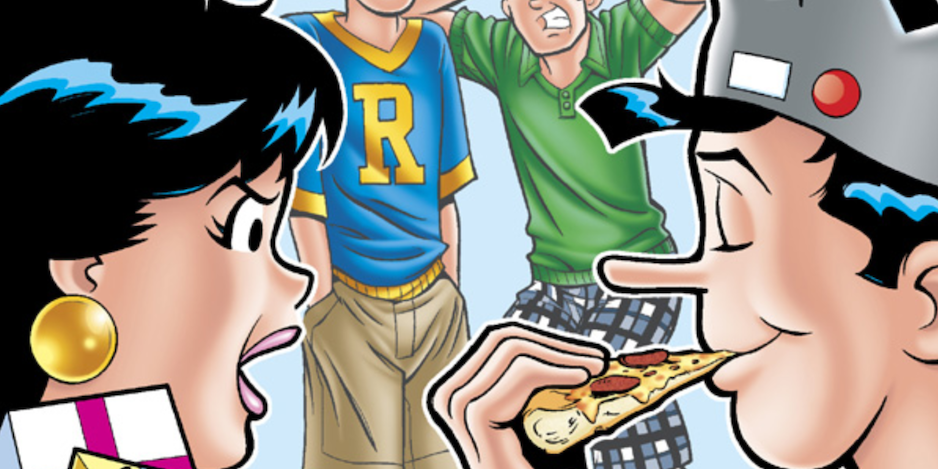
By PAUL KUPPERBERG
You may know me as the writer of countless exciting tales of superheroics and derring-do, but did you know there’s also a more playful side to my creative career in the young reader category?
In addition to writing the likes of Superman, the Doom Patrol, and Vigilante, I’ve also written a couple of dozen books for young readers, ranging from Superman, Batman and Wonder Woman chapter books for Stone Arch Books and the novel Kevin (starring Archie Comics’ Kevin Keller) published by Grosset & Dunlap, to nonfiction books on topics including history, science, and world events, as well as Mad Libs (Penguin Books), and color and activity books for Scholastic and Dalmatian Press… not to mention dozens of comic book stories starring Bart Simpson, Johnny Bravo, Scooby Doo and others.
(And now would be as good a time as any to mention my latest YA project, the novel Emma’s Landing, a time-traveling fantasy, fish-out-of-water story set in the Florida Everglades. You can check it out on my website here or on Amazon.
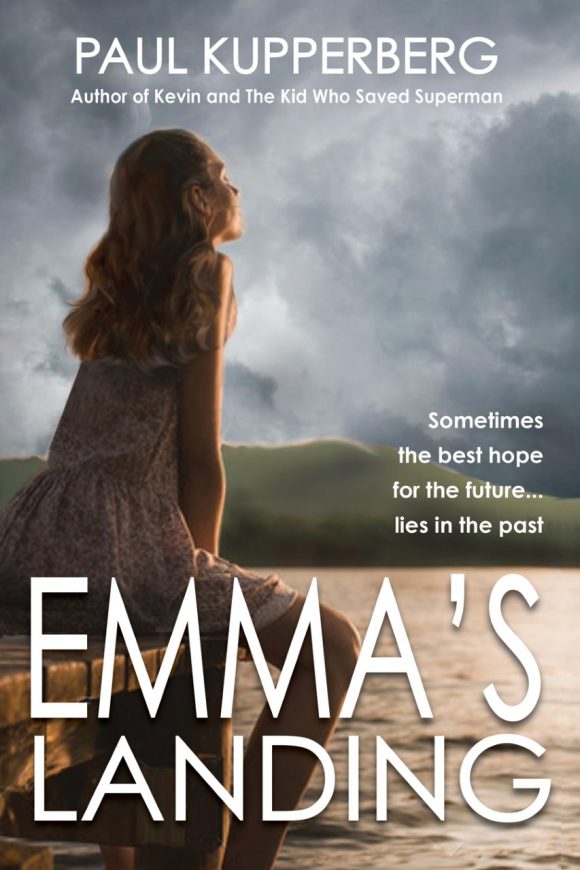
Other than a few years of writing movie parodies for Marvel’s Crazy Magazine (1979 – 1982), I didn’t get the chance to write much funny stuff, but by 1999, I had been rendered obsolete in superhero comics, so I started pitching to the editors of DC’s various Cartoon Network titles, several of whom proved receptive to my ideas. (Thank you, Kevin Dooley, Joan Hilty, Harvey Richards and Michael Siglain!)
Here then, MY 13 FAVORITE KIDS COMIC BOOK STORIES (That I’ve Written). In no particular order:
—
TrolLords #7 (Tru Studios, May 1987). The 1980s saw a boom in independent black-and-white comics sparked by the unexpected and explosive success of Eastman and Laird’s Teenage Mutant Ninja Turtles. There was a lot of good stuff mixed in with a lot of… not so good stuff, and one of the good ones was Scott Beaderstadt and Paul Fricke’s TrolLords, about a trio of dead trolls who sneak away from the afterlife when Death isn’t looking.
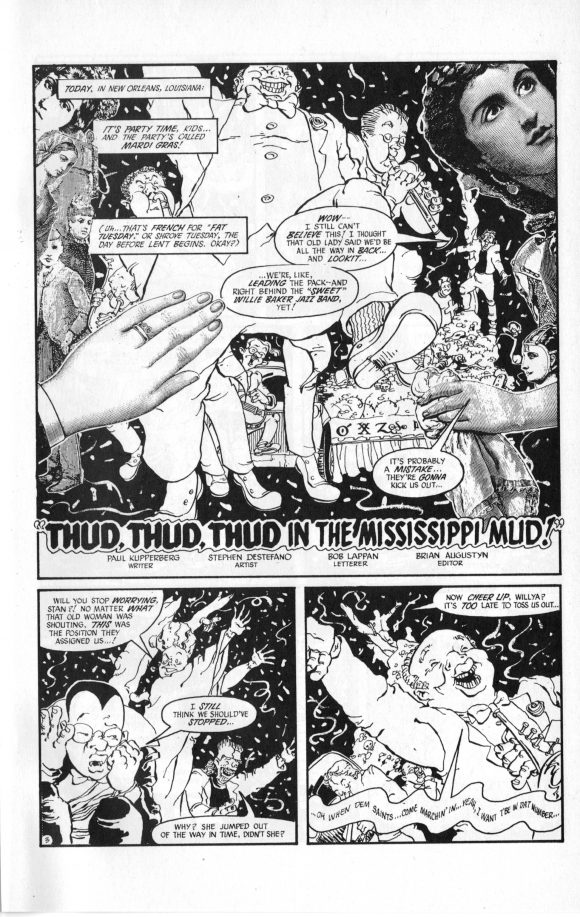
As the fates had it, as we say in comic books, TrolLords was edited by my buddy Brian Augustyn (who would soon join staff at DC Comics) who was responsive to the idea I had for a back-up story, “Thud, Thud, Thud in the Mississippi Mud,” set during Mardi Gras in New Orleans. And the fates were still having it, because Stephen DeStefano, cartoonist and co-creator of ‘Mazing Man agreed to draw it.
—
The Flintstones and the Jetsons #19 (DC, March 1999). In F&J #20, I’d finally sell a Flintstones story (“Sherock Stones”) I’d originally pitched to Charlton Comics in 1975 for their Flintstones title, but the Jetsons story from this issue has a better back story.
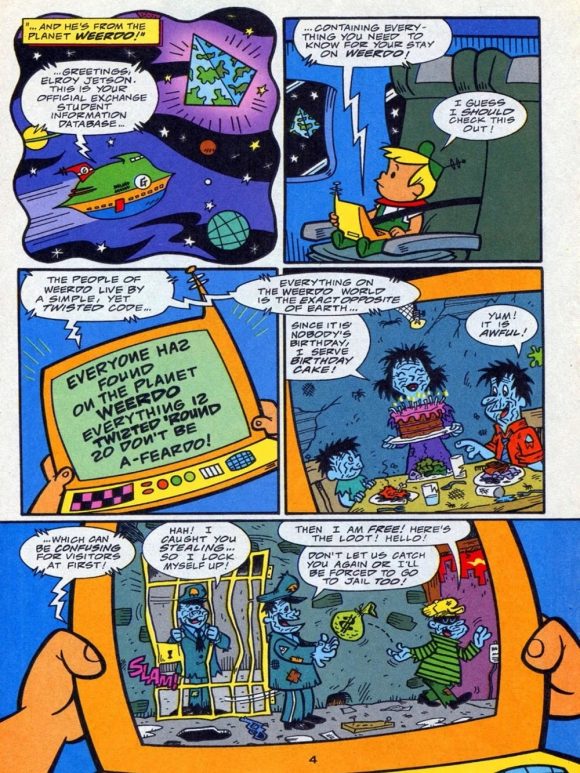
What I pitched to editor Kevin Dooley: Elroy Jetson as an exchange student on the Bizarro World. Kevin loved the “crossover” and, naturally, made his superiors aware that “Strange Exchange” (with art by Gary Fields) would include a DCU appearance in a Cartoon Network comic book. We figured it was all Warner Bros properties, so what was a little wink-wink/nudge-nudge between sister companies? As it turned out, we were a bit ahead of the times. I guess it would be another decade before a DC superhero would turn up in a cartoon comic, but Elroy on Bizarro World was not meant to be.
What was published: Elroy Jetson as an exchange student with the planet “Weerdo,” where “everything is twisted ’round” (the original script featured the entire Bizarro Code), while George, Jane and the rest of the Jetsons back on Earth have to put up with the backwards logic of “Yorle,” Elroy’s Weerdo counterpart. In the end, everybody learns to appreciate what they’d been taking for granted, but it would have been way better as a Bizarro story, that’s all I’m saying.
—
Bart Simpson #51 (Bongo, Sept. 2009). I heeded the wild beat of the Bongo and pitched some ideas to Simpsons comics editor Bill Morrison and, d’oh! He bought ’em! Among them was “Bart’s Invisible” (with art by Carlos Valenti and Shane Glines), a story in which Bart believes he’s been turned invisible by one of Professor Frink’s (floin-hey!) inventions and proceeds to take advantage of the situation by helping himself to anything he wants. Of course (woo-hoy!) he’s not really invisible; his “victims” just happen to be too busy or preoccupied to confront him… until they do. At the end of the story. All at once.
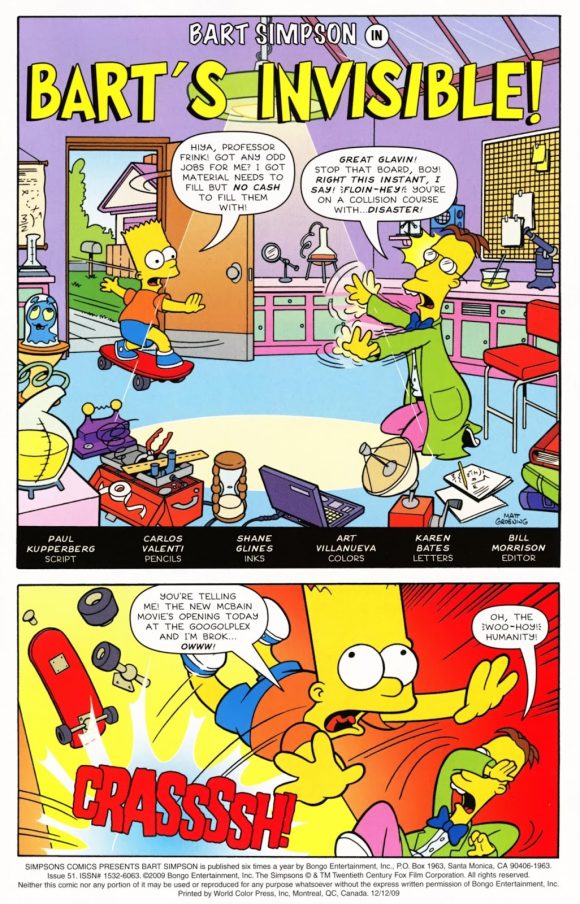
—
Cartoon Network Starring #3 (DC, Nov. 1999). I could claim I intended “Komic Kon” as an ironic commentary on the worship of comic-creator superstars and the era’s out-of-control speculators market, but honestly, I really just wanted to unleash the unhinged I.R. Baboon on a comic book convention.
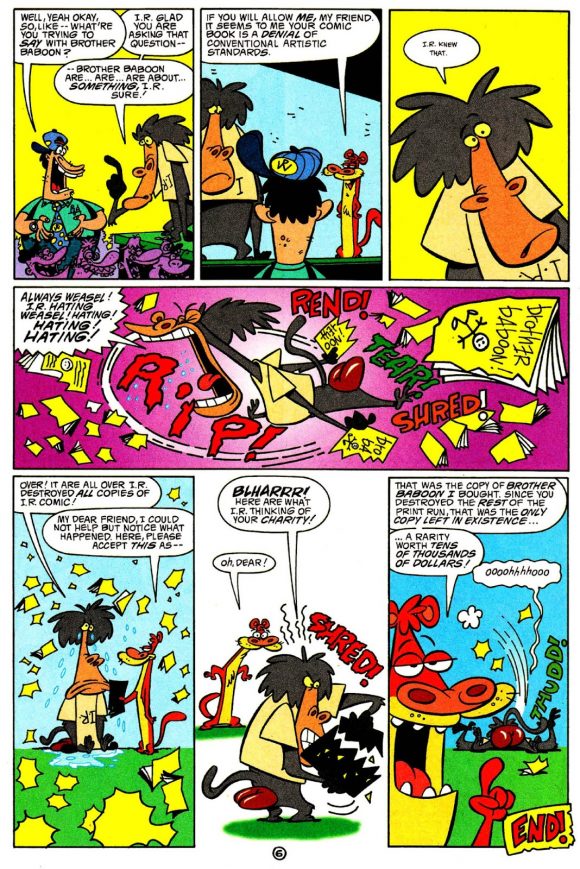
And, y’know, make fun of the worship of comic-creator superstars and the era’s out-of-control speculators market. Anyway, Tim Harkins drew the heck out it.
—
Cartoon Cartoons #4 (DC, June 2001). Of all the cartoon comics I wrote, I probably had some of the most fun writing the I Am Weasel feature. I’ve always had a thing for absurdist humor, and Weasel and Baboon was the perfect playground for absurd.
“The Test of a Baboon,” illustrated by Gary Fields, had its inspiration in a far earlier absurdist TV show, the 1950s Abbott and Costello Show. In it, Bud and Lou were played as two down on their heels schmucks living in a boarding house, surrounded by an odd assortment of a supporting cast, and always on the hustle for a job to pay the rent.
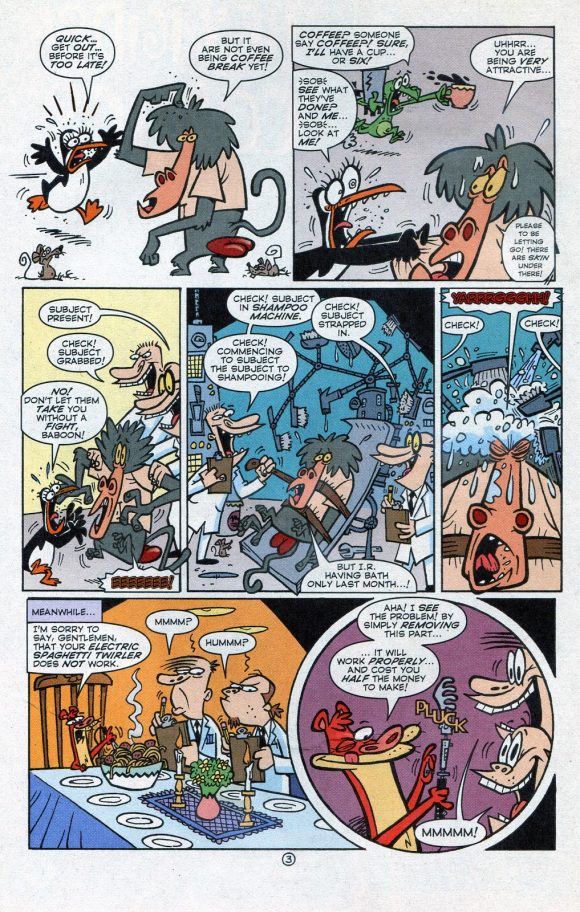
The “test” in the title is as a guinea pig in a corporate laboratory, where Baboon accidentally starts a revolt of the rest of the test animals — including a chicken testing toothpaste and a penguin in eye make-up — and gets both him and Weasel, whose brilliance has already gotten him promoted to a top executive position, fired.
—
Cartoon Cartoons #19 (DC, Aug. 2003). I watched a bunch of Cartoon Network shows in preparation for writing these characters, and while I didn’t feel quite the same love for Courage the Cowardly Dog as I did for I Am Weasel or Johnny Bravo, I’m a sucker for surrealist humor, and Courage was nothing if not surreal.
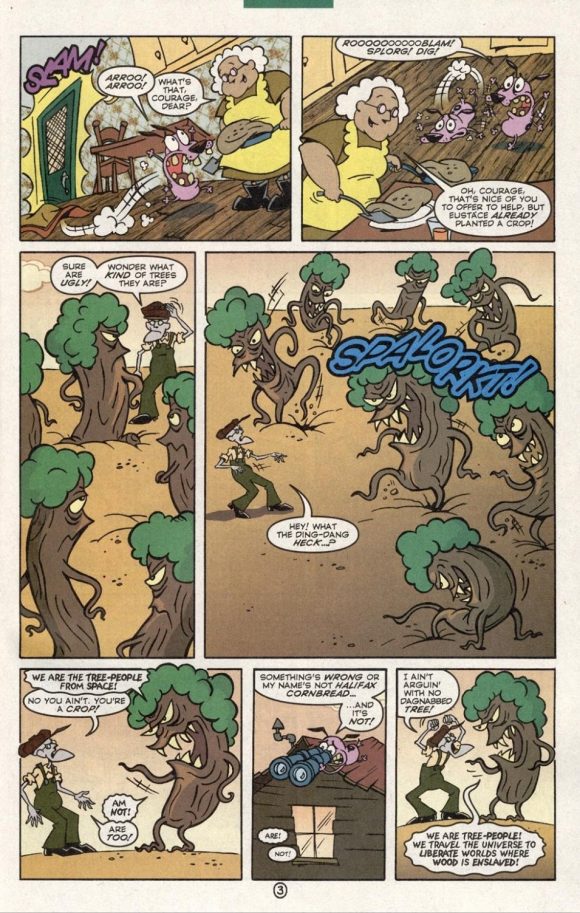
Living with a weird old couple on a farm in the middle of literal Nowhere, Courage and his people were magnets for the bizarre, supernatural and extraterrestrial. I brought a little of my native Brooklyn surrealism to “A Tree Grows in Nowhere” (with art by Enis Temizel and Tim Chi Ly), loosely based on Betty Smith’s 1943 novel, A Tree Grows in Brooklyn. Very loosely. Really just the title.
—
Cartoon Cartoons #22 (DC, Nov. 2003). Johnny Bravo was just too stupid not to be absolutely irresistible and I wrote a bunch of these, ranging from one- and two-page fillers on up to full shorts like “Johnny Delivers,” another story illustrated by the similarly irresistible Stephen DeStefano.
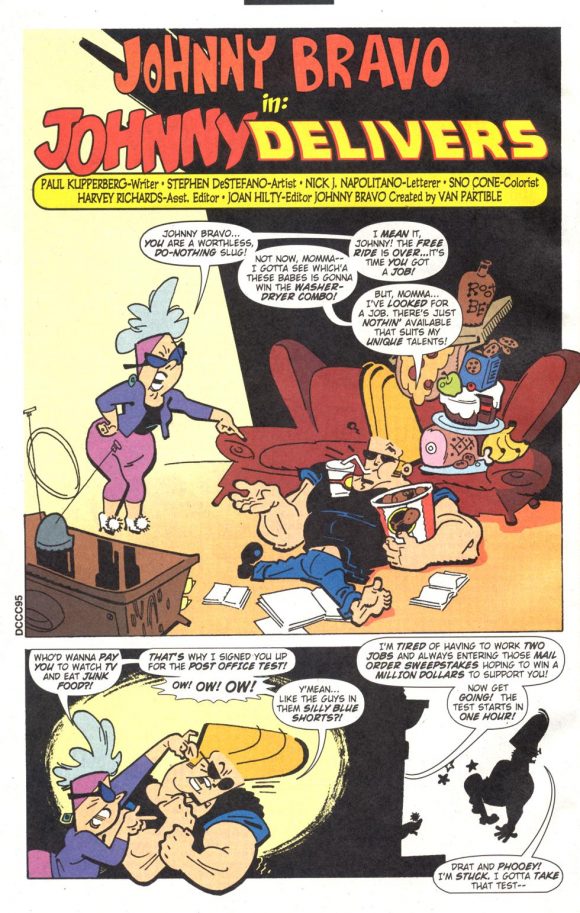
Johnny’s Mama, sick of Johnny being a bum, gets him a job at the post office where mayhem and hilarity ensues, causing Johnny to be fired for burning down the P.O. — including the winning contest entry Mama had mailed that day. That’ll teach her, huh!
—
Scooby-Doo #143 (DC, June 2009). I also wrote a bunch of Scooby-Doo stories, my absolute favorite being “Sunday in the Park with Scooby,” beautifully drawn by the talented Fabio Laguna. The folks over at WB who approved these stories were usually pretty adamant about keeping characters and stories on model, but “Sunday in the Park” didn’t quite follow the regular prescription. Rather than have the entire gang stumbling across a mystery, the story followed Shaggy and Scooby on a walk through the park where, without even knowing they’re doing it, casually solve several little mysteries and lead the police to the arrest of a cunning criminal.
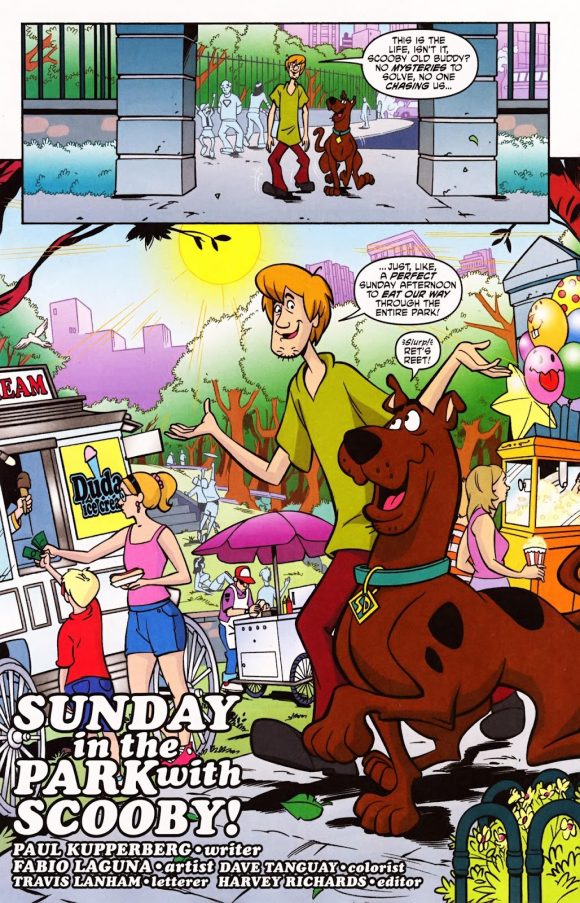
—
Scooby-Doo #159 (DC, Oct. 2010). Another favorite Scooby story is “Attack of the 50-Foot Shaggy,” again drawn by Fabio Laguna. On a visit to a college campus by the gang, Shaggy falls victim to a scientist’s enlarging ray, which causes him to start growing. Or… does it? The mystery is ultimately solved (thanks to a Scooby snack!), but the story behind the story is that John Byrne had originally agreed to draw it until a last-minute scheduling conflict caused a change in plans. “Rohn Ryrne Rooby Roo?! Ruh-roh!”
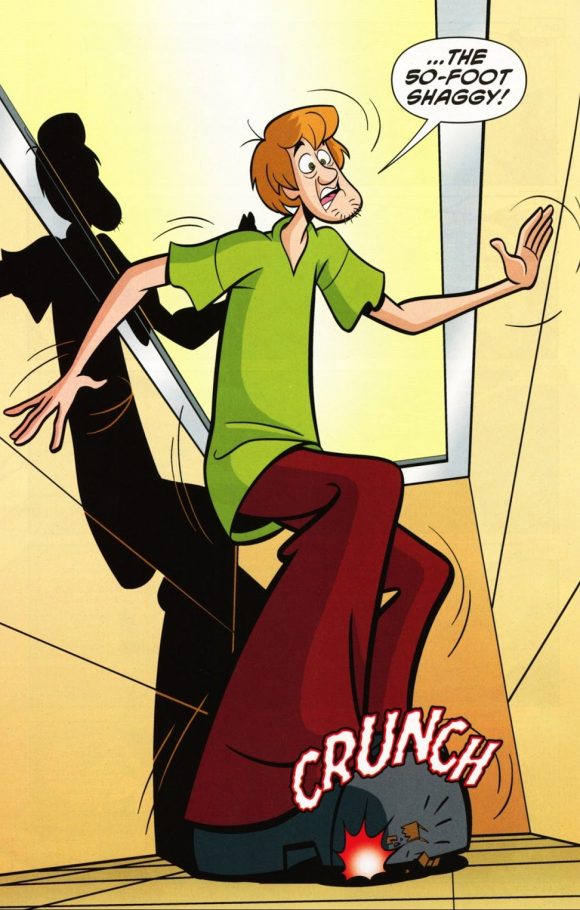
—
Archie’s Pals ‘n’ Gals Double Digest #146 (Archie, Jan. 2011). “All the Doggone Day” was the first story I wrote for Archie Comics, before I was offered the Life With Archie series, but not published until after. In it, Archie offers to pick up Mrs. Lodge’s prize pooch from the groomer’s and deliver it safely to the dog show, which he does, but only after a series of near disasters.
What surprised me was how easy it was to slip into writing these characters; I immediately went to Archie’s characteristic over-eagerness, his headlong plunge into being helpful without any thought to consequences. I’ve been reading Archie since I’ve been reading comics and after all those years of exposure, the Riverdale gang were as familiar to me as family.
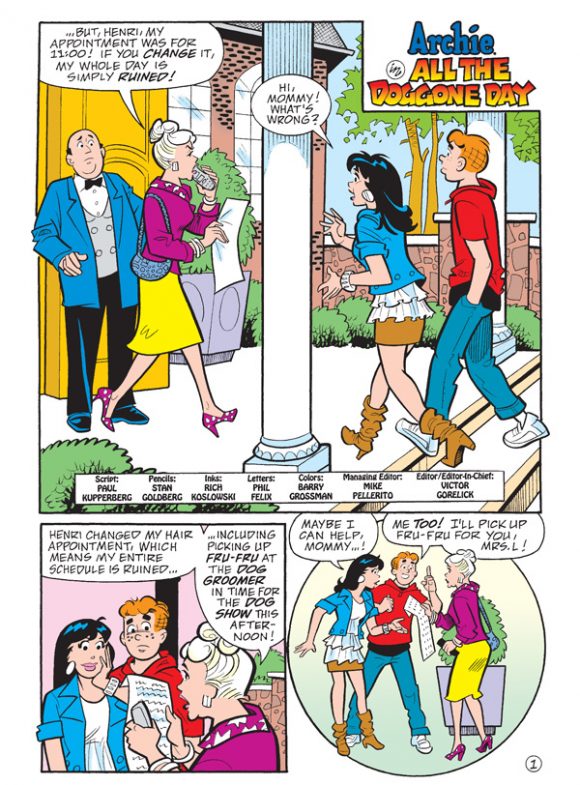
Bonus points (for me): “All the Doggone Day” was penciled by the late, great Stan Goldberg (and inked by Bob Smith). When I met Stan at a convention after he had drawn a few of my stories from typewritten scripts, the artist, accustomed to working from scripts done in the form of thumbnail sketches, said, “You’re the one who uses all the words.”
—
Jughead Double Digest #172 (Sept. 2011). Further proof (to myself) that I “got” these guys, I wanted to do a sort of quintessential Jughead story, but not an obvious one about his relationship with hamburgers. Instead, “Treasure Hunt” was based on my theory that Jughead Jones was the smartest person in Riverdale. Not brainy like Dilton, or a financial wizard like Mr. Lodge, but shrewd in a streetwise, intuitive way. Jughead knows how people tick and he doesn’t hesitate to exploit his knowledge to get what he wants.
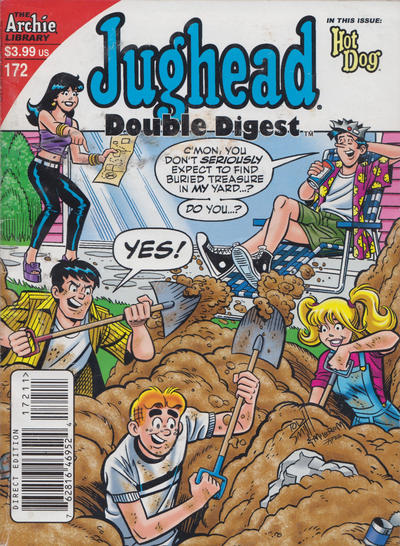
Hence “Treasure Hunt,” with art by my old Vigilante and Peacemaker collaborator Tod Smith and inker Terry Austin. An old map the gang finds in the Jones’ attic that indicates that John Dillinger might have buried his loot in the backyard in the 1930s has everyone picking up shovels to find the treasure. Except for the skeptical Jughead, who sits out the hard labor until (punchline!) we find out Jughead planted the map so his friends would find it and dig up the yard for the new septic system his parents were having installed. He’s a genius, I’m telling you!
—
Jughead Double Digest #173 (Oct. 2011). “B.F.F…. Not!” was another character-driven story (art again by Tod Smith, this time inked by Al Milgrom), focusing on the often-hostile relationship between Jughead and Veronica. Despite their constant bickering and sniping at one another, when the chips are down, Jughead leaps to Veronica’s defense. ’Cause that’s what friends do.

—
Jughead Double Digest #191 (Dec. 2013). I totally plagiarized the story “What Were You Thinking?” Not intentionally, of course. One day, while sitting with my pad and pencil coming up with Archie springboards, I had the idea for a story where Jughead claiming to be able to read minds, tells the gang that Mr. Weatherbee is planning to retire. No one believes him, until they start overhearing clues that this might indeed be the case until (punchline!) — they learn that Weatherbee is indeed going to “retire”… that is, buy new wheels for his car.
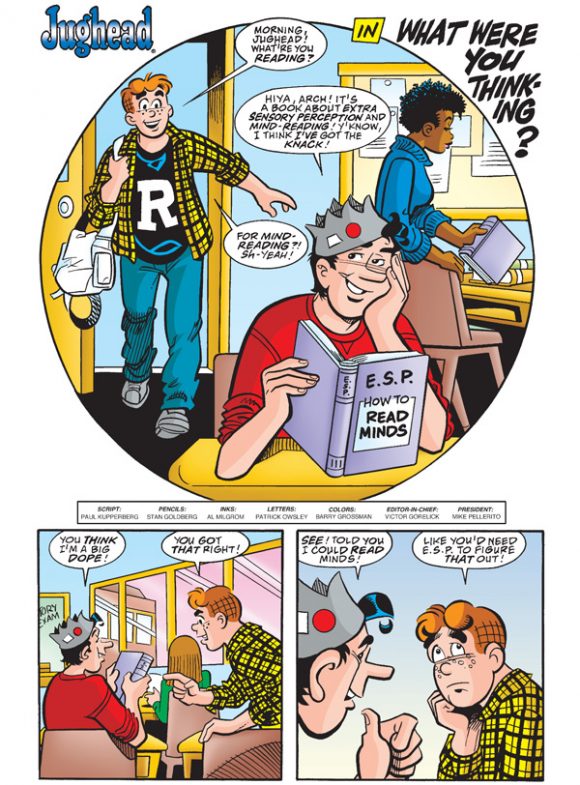
It was a cute little 6-pager, especially as drawn by Stan Goldberg and Al Milgrom, and I didn’t give it any further thought until a year or two later when I came across a stack of old 1960s Sad Sack comics that had been in storage forever and flipped through them. And found a story where one of Sad Sack’s bunkmates, reading a book about ESP, says he can read minds and to prove it, tells them he knows that Sarge is planning to “retire”…!
Oops.
—
MORE
— PAUL KUPPERBERG: My 13 Favorite Comic Book Back-Up Stories. Click here.
— PAUL KUPPERBERG: My 13 Favorite Short-Lived Series of the 1960s. Click here.
—
Paul Kupperberg has been writing comic books from Archie to Zatanna for 45 years at DC, Archie, Charlton, Marvel, Bongo and others. He is also the author of Paul Kupperberg’s Illustrated Guide to Writing Comics (Charlton Neo Press); I Never Write for the Money… But I Always Turn in the Manuscript for a Check (Comics Career); the comic book industry-based murder mystery The Same Old Story, the short-story collection In My Shorts: Hitler’s Bellhop and Other Stories, JSA: Ragnarok, and his latest, the YA fantasy/time travel adventure Emma’s Landing, all from Crazy 8 Press and all available on Amazon, or signed and personalized direct from Paul (email him at pkupps55@yahoo.com for details).

June 3, 2021
Now you’ve got me wondering how the Scooby Gang would look in John Byrne’s style. 🙂